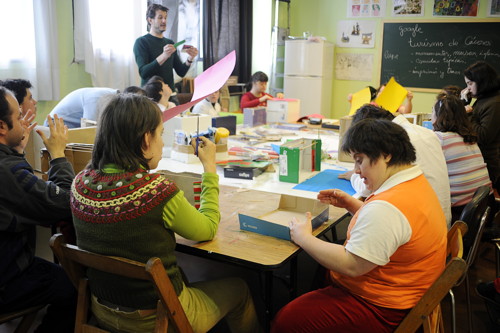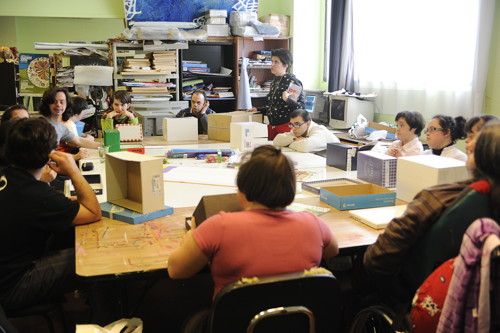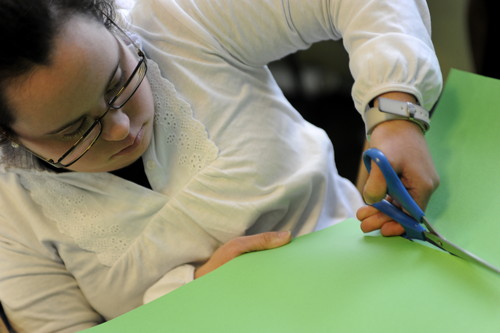3.2.9 Teaching People at Danza Mobile
Teaching people at the school of Danza Mobile requires a very open working frame. In Spain it is not required to go to school when you have a disability, therefore you never know how many students will show up at your workshop. It is also possible that parents come into your classroom and take their child out of the class for however long they desire. When you have a mental disability your parents decide for you even if you are 30 years old and you would actualy like to finish your performance. As a teacher you have to work with the parents also. Some parents are supportive and others not.
For many people the school is like a birds nest, as one of the students (Danny) said it. It is a place where they can feel at home and accepted. It is also a place where they can prepare themselves to function in society and where they can learn a proffession that they can live from. For example being an actor, a poet, a dancer or a painter... or even all at the same time.
People with Down Syndrome are very emotional. When they are angry at someone, it needs to be solved immediatley it can not be left until the class is over. They are living in the moment and are communicating in a very honest and direct way. They use their body and sounds to express themselves because not all of them can speak properly.
As a teacher I was fascinated by the way they could concentrate on one little detail, for example, a pizzaiolo who is turning his Pizza around. They can watch this for a very long time. All of a sudden they stand up from the table from which the were eating, take the pizza over from the pizzaiolo and start to immitate perfectly what they had just seen. I can say that the owners of the restaurant were very surprised and pleased to see them do this.
When I teach I see their potential and not their disability.
That's why the book of Paulo Freire really touched my heart and confirmed to me that the way I am teaching is appropriate.
* Page 78
"From the beginning the intervention needs to go from the point that the teacher needs to have a deep trust, that the student is able to create. To reach this the teacher needs to partner up with his students."
I chose this quote because for the people at Danza Mobile I am their friend. I am somebody that has a disability as well and therefore I win their trust. I don't tell them what to do but I give them different options so that they can find out what they want themselves. I can show them what is possible, even when you have a disability.
In general I see my role as a teacher as one of support not one of authority. I would like to give the people, with or without disability, confidence to find their own solutions and allow them to experiment in a creative way. In my teaching the process is more important than the result. I trust that people have the power to teach themselves and what they have learned they teach me. Difference is the norm in my classroom. Therefore I use an individual aproach to guide each student to reach his/her own potential. Education doesn't end outside the classroom, for me it is a way of life and my biggest passion.
The book: " ...und ich war nie in der Schule – Geschichte eines glücklichen Kindes" written by André Stern, was also one of my inspirations.
The book is about a boy that has never been to school because in Paris it is not obligatory to visit school. The parents decided to teach the boy themselves. they gave him the opportunity to freely choose what he wants to learn. He is now speaking five languages, he is a journalist and builds guitars himself...!
I think it is ideal to be teached this way when you have good relationship with your parents, however... one can argue that this is not always the case.
One thing Paulo Fereira and André Stern have in common is that they follow the interest of the child/adult while teaching and that I find fantastic.








